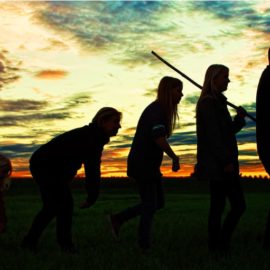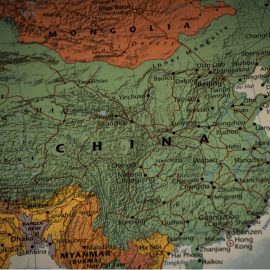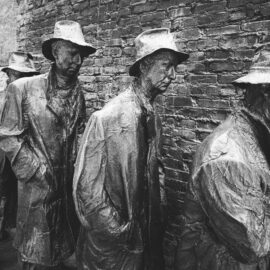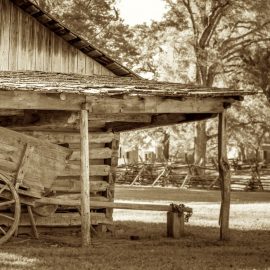
What was the role of Native Americans during the Civil War? How were they involved?
During the Civil War, Native Americans were subject to many anti-indigenous policies and racism, and many responded by fighting to divide the United States. By joining in the war, Native Americans hoped to weaken European forces.
Continue reading to learn how indigenous people were affected by and involved in the Civil War.
The Civil War Years and Industrialization
When the US annexed Mexico, which didn’t allow slavery, it sparked a debate over slavery that would culminate in a civil war. During the Civil War years and the period of greater industrialization that ensued, US violence against Native American peoples continued. In this article, we’ll discuss some of the federal policies that led to this violence as well as resistance from Native Americans during the Civil War.
(Shortform note: The American Civil War began in 1861 when several southern states seceded from the Union (the US) to form their own government, the Confederate States of America. The Confederate states seceded because the US government challenged their right to legalized slavery, upon which the southern states’ economies depended. The US won the war in 1865, reincorporated the Confederate states into the US, and federally abolished slavery. In the aftermath of the war, Southern states ratified Jim Crow laws to reinforce Black people’s legal inferiority; these laws were later repealed, but systemic racial injustice remains a contentious issue in American culture, as Michele Alexander explains in The New Jim Crow.)
Anti-Indigenous Policies During and After the Civil War
Abraham Lincoln, who was president during the Civil War, won the presidency in part because of an anti-indigenous policy he supported called “free soil,” which invited settlers to take over indigenous lands. Lincoln engaged in other anti-indigenous actions, too: For example, when he recalled military forces that had been stationed in the West to fight the Civil War in the East, he asked settlers to volunteer to take their place and help keep indigenous populations weak and subordinate. This led to many notable instances of genocidal violence—for example, in the Long Walk of 1864, a volunteer militia forcibly marched 8,000 Diné people to a concentration camp, where they were incarcerated for four years.
(Shortform note: You might be surprised to learn that Lincoln took anti-indigenous actions, given that he’s most famous for emancipating Black Americans and ending slavery in the US. However, historians note that while Lincoln is usually remembered positively for making progress toward racial equality, he didn’t personally believe in racial equality. In addition to professing anti-Black views, Lincoln oversaw multiple mass executions of Native American people, and the free soil policies Lincoln supported had, in some cases, merely replaced enslaved Black people with enslaved Native Americans. The Long Walk—a direct result of Lincoln’s actions as president—has been compared to the Trail of Tears, since it resulted in mass Diné casualties.)
The Civil War escalated industrialization, which ignited a new era of anti-indigenous policies. First, the US began to break treaties by giving indigenous lands and resources to private companies and citizens for homesteading and for building universities, corporations, and railroads. To protect these interests, the US waged genocidal wars against western indigenous nations such as the Sioux. The US also systematically hunted buffalo (a primary Native American resource) to near extinction, which destroyed ecosystems and economically disabled indigenous peoples. Then, in 1871, Congress passed legislation that put an end to treaty-making and gave the US final authority over indigenous affairs.
(Shortform note: The Civil War escalated industrialization by ramping up demand for machinery, railroads, and manufactured goods to support the war effort. Industrialization threatened Native American life by increasing pollution of natural resources and disrupting natural habitats. The rise of railroads during industrialization also contributed to the extinction of buffalo—buffalo were hunted extensively to feed railroad workers and prevent train delays that resulted when herds crossed the tracks. Many experts also believe the US hunted buffalo in an explicit effort to starve Native Americans. The US hoped to fully assimilate the Native Americans who survived the genocide—that’s why it ended the practice of treaty-making.)
In the late 1800s, these developments led to allotment legislation that affected indigenous peoples living in designated Indian territories. Instead of holding collective ownership of community lands, individual families would own smaller parcels (with some families owning none), and the rest would be given to Anglo-American homesteaders. Around the same time, US officials also opened boarding schools that incarcerated and aimed to assimilate indigenous youth, who were banned from (and brutally punished for) expressing their native cultures. Both land allotment and boarding schools exacerbated native poverty and weakened the sovereignty and cultural influence of native nations.
(Shortform note: Allotment legislation was another attempt to forcibly assimilate indigenous Americans into the dominant US culture—proponents believed that private land ownership was integral to a civilized society and that Native Americans would naturally adopt the Anglo-American lifestyle by participating in this tradition. Boarding schools aimed to assimilate those who weren’t old enough to own land—by 1900, about 20,000 native children were enrolled in these institutions, where they were often subjected to neglect and abuse. Many children died as a result; in 2022, the US released a report identifying over 500 such deaths and explaining that many were buried in unmarked graves.)
Native American Resistance During and After the Civil War
Native Americans continued to employ violent resistance as a survival strategy both during and after the Civil War. Many indigenous peoples saw the Civil War as an opportunity to divide and weaken the US (and therefore subvert its ability to disrupt native life)—this motivated various native nations to fight alongside either Confederate or Union forces during the war.
(Shortform note: Historians explain that just as the Civil War fragmented the US, it also deepened intra-community conflict among indigenous peoples, especially inside the Cherokee nation: The Trail of Tears had led to a political divide between two segments of the Cherokee, and the leaders of both divisions signed contentious agreements with the Confederates, which prompted some Cherokee to desert their communities and join Muscogee forces aligned with the Union.)
When industrialization threatened their communities after the Civil War, indigenous peoples continued to battle. For example, war leaders Crazy Horse and Sitting Bull led Sioux resistance movements which won significant battles, like the Battle of Little Bighorn in 1876, and evaded capture for long periods of time.
(Shortform note: Crazy Horse and Sitting Bull led the Sioux resistance to protect the Black Hills—land considered sacred by its indigenous occupants, who were being displaced by settlers and resource extractors. The Battle of Little Bighorn was part of the Black Hills War, and although the Sioux won that major battle, the US military later forced the resisters to surrender. As of 2023, the Crazy Horse Memorial is in progress in the Black Hills, and it promises to dwarf Mount Rushmore (a monument of four US presidents carved in the Black Hills in 1927, which many indigenous people find insulting). The sculptor who began the Crazy Horse Memorial, Korczak Ziolkowski, also crafted the Sitting Bull Monument that sits in Mobridge, South Dakota.)
However, Dunbar-Ortiz explains that violent native resistance would soon come to an end. The Sioux, who were impoverished and confined to exceedingly small reservations, began the Ghost Dance movement—a dancing ritual that aimed to restore traditional indigenous lifeways. US officials were spooked—and in response, they massacred 300 Sioux at the so-called Battle of Wounded Knee in 1890. By this time, Native American nations had been so weakened by US genocide that this massacre effectively marked the end of US-indigenous warfare.
(Shortform note: Experts explain that there were actually two Ghost Dance movements: First, around 1870, Wodziwob taught that the Ghost Dance could revive those recently lost to disease. Then, in 1890, Wovoka (who was heavily influenced by Christianity) prophesied that Native American life would be restored and coexist peacefully alongside Anglo-American life. Many of Wovoka’s followers believed the Ghost Dance would resurrect indigenous ancestors, repopulate the buffalo, and wipe out white settlers—which is why US officials were so spooked. Some experts believe that in addition to worries about the Ghost Dance, US officials carried out the massacre at Wounded Knee out of anger over their defeat at the Battle of Little Bighorn.)






